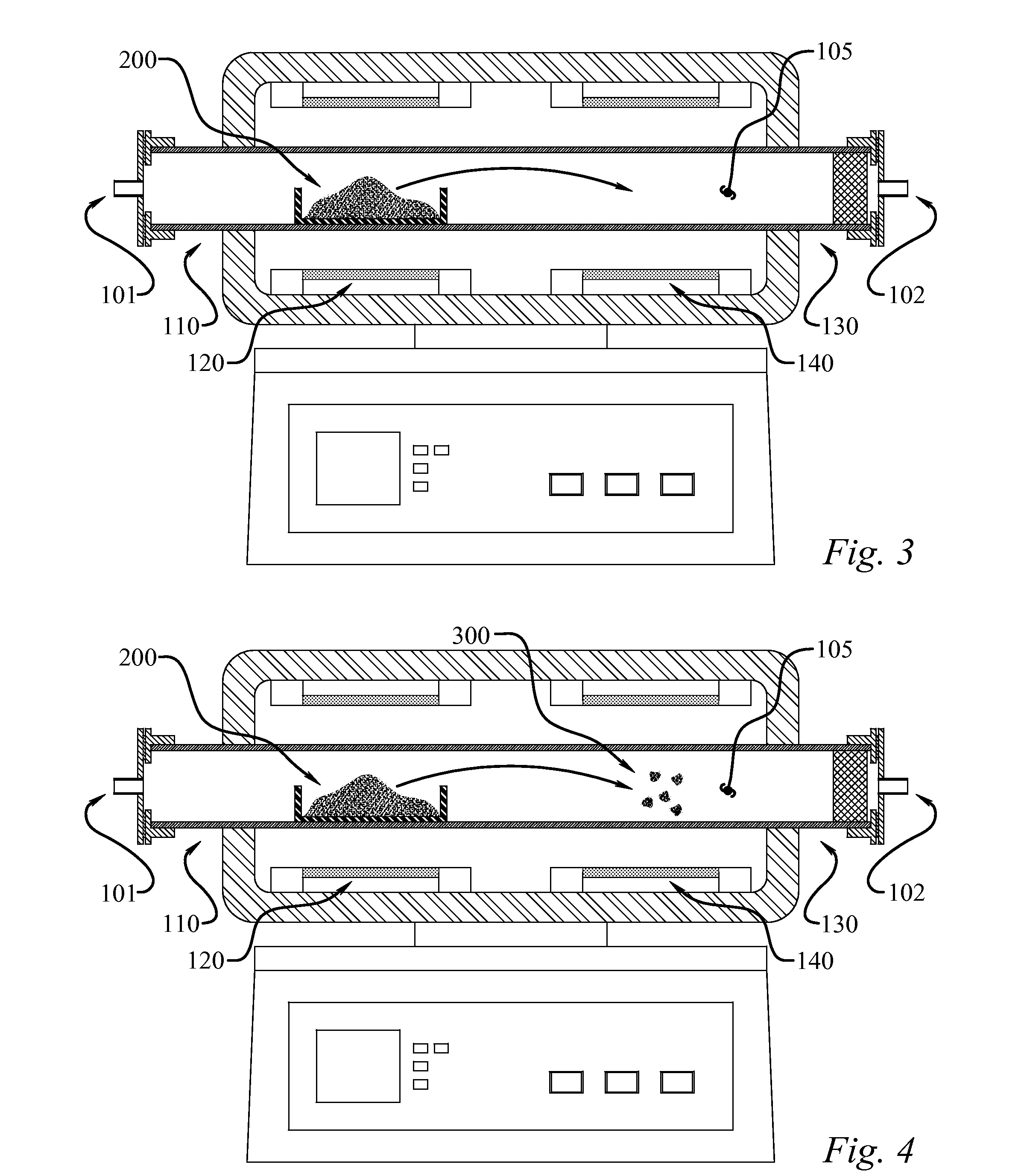Method for producing bn-based nanoparticles and products therefrom
a technology of boron nitride and nanoparticles, which is applied in the direction of transportation and packaging, chemical instruments and processes, coatings, etc., can solve the problems of advanced wear and erosion of metals, chemical interaction of the barrel, and the wear of the gun barrel via mechanisms, so as to improve the energetics of the propellant, facilitate the dispersion of propellants, and prolong the life
- Summary
- Abstract
- Description
- Claims
- Application Information
AI Technical Summary
Benefits of technology
Problems solved by technology
Method used
Image
Examples
example 1
[0055]In one example experimental procedure, gaseous BNHx material was produced from ammonia borane through heat-mediated decomposition at 100° C. to approximately 225° C., with a 50° C. / min heating rate, and the resultant gaseous matter was carried to a heat zone at 1000° C. using a nitrogen carrier gas. The BNHy solid product deposited in the exhaust line as a white powdery residue. The material was then dispersed in isopropyl alcohol and deposited on gold-coated slides for SEM analysis. Based on the SEM images in FIGS. 6 and 7, the product consisted of spherical sub-micron particles. TEM with EELS analysis confirmed that this product has a B:N ratio of about 1:1 (data not shown). The product nanoparticles were analyzed by x-ray diffraction to determine their crystal structure. As seen in FIG. 8, the product lacked a strong diffraction pattern relative to commercial hexagonal boron nitride, indicating the product material is amorphous. As noted, had higher temperatures been applie...
example 2
[0056]The product from a second run at 800° C. in the hot zone was also prepared. For this sample, 0.800 g of ammonia borane was loaded in a chamber. The chamber was heated from room temperature to 225° C. at 5° C. / min under nitrogen flow at 200 cc / min at 1 atm. The gas then passed directly to the 800° C. hot zone. After the run, the sample was collected from the exhaust line and imaged using SEM. This product was noticeably stickier than the powdery “soot-like” product formed in higher temperature run. The product appeared to be soluble in isopropyl alcohol, and formed crystal deposits on the glass substrate as the alcohol was evaporated. It is hypothesized that the product is the BNHy analogy to hydrocarbon tar, which forms during decomposition of hydrocarbons at lower temperatures than soot formation.
example 3
Polymer Composite Preparation
[0057]First, 1 gram of BN nanoparticles was added to 50 grams of 1:1 ethanol:acetone, and stirred vigorously for 20 minutes to form a nanoparticle dispersion. Then, the dispersion was combined in a rotating container with 50 grams of IMR-4198 propellant (available commercially from Hodgdon). The container was sealed, and the mixture was rotated for 2 days in the container to form a uniform dough-like mixture. Finally, the liquid solvent was evaporated under ambient conditions, leaving behind approximately 2-weight percent boron nitride nanoparticles dispersed throughout the propellant matrix.
[0058]The composite was tested by Differential Scanning calorimetry (DSC). DSC measures the temperatures and heat flows associated with transitions in materials as a function of time and temperature in a controlled atmosphere. These measurements provide quantitative and qualitative information about physical and chemical changes that involve endothermic or exothermic...
PUM
| Property | Measurement | Unit |
|---|---|---|
| pressures | aaaaa | aaaaa |
| pressures | aaaaa | aaaaa |
| temperatures | aaaaa | aaaaa |
Abstract
Description
Claims
Application Information
 Login to View More
Login to View More - R&D
- Intellectual Property
- Life Sciences
- Materials
- Tech Scout
- Unparalleled Data Quality
- Higher Quality Content
- 60% Fewer Hallucinations
Browse by: Latest US Patents, China's latest patents, Technical Efficacy Thesaurus, Application Domain, Technology Topic, Popular Technical Reports.
© 2025 PatSnap. All rights reserved.Legal|Privacy policy|Modern Slavery Act Transparency Statement|Sitemap|About US| Contact US: help@patsnap.com



